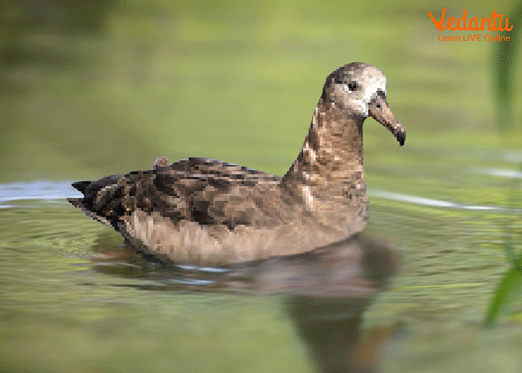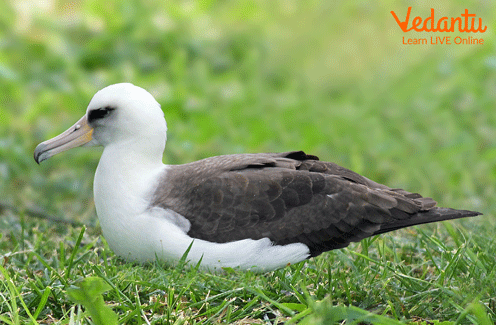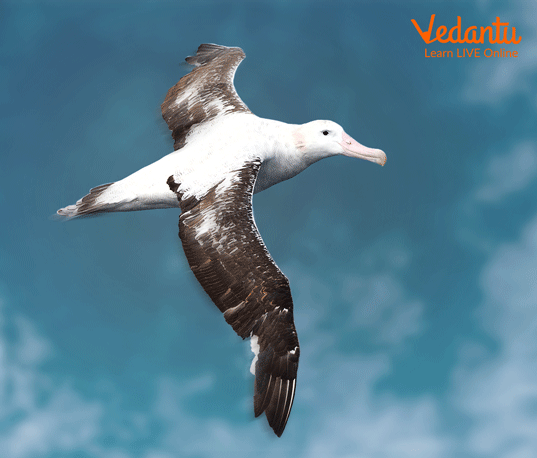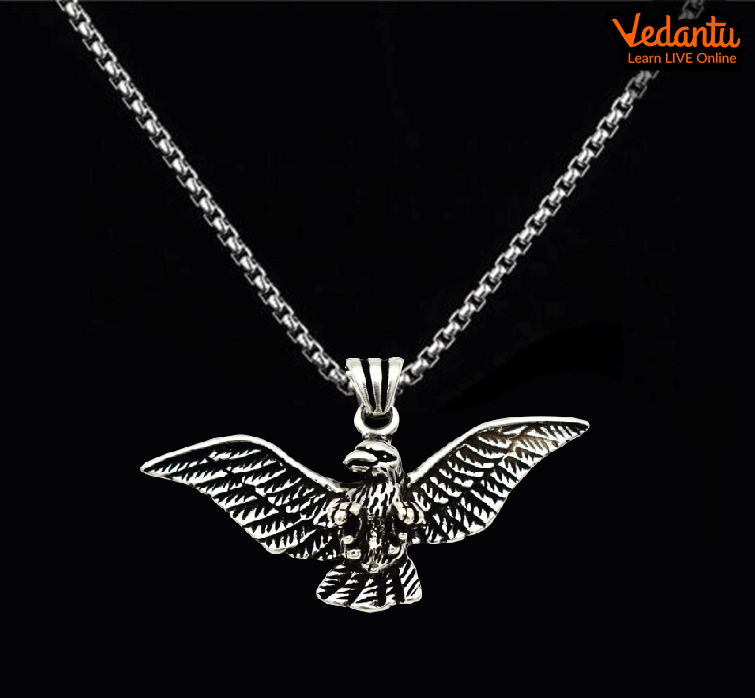




An Introduction to Albatross
The albatross is one of the most remarkable seabirds on the planet, known for its massive wingspan- some reaching up to 12 feet. These majestic birds spend most of their lives soaring over vast oceans, using the wind to glide effortlessly for hours without flapping their wings.
Found mainly in the Southern Ocean and North Pacific, albatrosses are expert fishers, feeding on squid and small fish. Despite their elegance, they face threats like plastic pollution and climate change.
With their graceful flight and deep-sea wanderings, albatrosses symbolise freedom, endurance, and mystery- a true marvel of the avian world!
Albatross
Albatrosses are magnificent birds that spend the vast majority of their lives flying over water.
Albatrosses live much longer lives than most other birds and wild animals. Laysan albatrosses, for example, have an average lifespan of 12 to 40 years, though there is evidence that these birds can live much longer.
Wandering albatrosses have the largest wingspan of any bird in the world, measuring up to 12 feet (3.7 metres) across. Wandering albatrosses are the largest species of albatross.
Albatross bodies are proportional to their wingspans. The smallest albatrosses stand just under three feet tall, while the larger species reach heights of more than four feet. They weigh between 17 and 22 pounds on average.
They have an extremely well-developed sense of smell, which aids them in identifying potential food sources as they dive. Krill, squid, small fish, and crustaceans are their main sources of food. They will also consume carrion (dead animals) found floating on the ocean's surface.
Scientific Name of Albatross
Albatross is a member of the family Diomedeidae. The scientific name of the albatross (royal) is Diomedea epomophora. These belong to the order Procellariiformes. They enjoy stormy and windy conditions.
Laysan (phoebastria immutabilis) and black-footed albatross (phoebastria nigripes) are two subspecies of albatross.
Albatross Evolution and Relatives
Albatrosses evolved millions of years ago from ancient seabirds, adapting to life over the open ocean. They belong to the Procellariiformes order, sharing ancestry with petrels and shearwaters. Their tube-nosed beaks and massive wingspans set them apart, allowing them to soar effortlessly for miles.
There are four major genera of albatrosses:
Diomedea (Great Albatrosses)
Phoebastria (North Pacific Albatrosses)
Thalassarche (Mollymawks)
Phoebetria (Sooty Albatrosses)
Albatross Lifespan
The albatross has a life span of approximately 50 years. Only one egg is produced by the female. The parents look after their child. Before reaching adulthood, the infant learns to fly, approximately after 3-10 months and then, leaves the land.
Albatross Wings
Albatross is a sea bird and has a pair of wings to fly over the water surface. The wings of the albatross are wide. An albatross may have a wingspan of up to 11 feet. Albatros's wingspan is almost double the size of the body. The albatross uses its wings to glide through the ocean breezes, sometimes for hours at a time without stopping or even beating its wings. The birds' large wings allow them to travel further distances.
Bird with Longest Wingspan
The wandering albatross (diomedea exulans) is the world's biggest flying bird, with a wingspan of roughly 12 feet. It belongs to the order “Procellariiformes” of sea birds. The royals have a 236-day nestling phase, whereas the wanderers have a 278-day nestling period due to strong and chilled winters.
Albatross Images

Black-Footed Albatross (Phoebastria Nigripes)

Laysan (Phoebastria Immutabilis)

Wandering Albatross (Diomedea Exulans)
Albatross Bird Locket
The Albatross bird symbol is used in lockets and jewellery as a symbol of good luck for travellers in the sea and ocean. Nowadays, these are used in jewellery and sold in the market. Albatross is a sea bird and helps in path detection for mariners.

Albatross Bird Locket
Albatross Facts
These birds get together in groups during their breeding and mating time. They mostly live on the surface of seawater but during breeding time, these birds migrate toward land. These birds travel only for food searching, weather conditions and breeding.
Migration Patterns of Albatrosses
Albatrosses are long-distance travellers, covering thousands of miles across oceans. Using wind currents, they glide effortlessly for weeks without stopping. Some, like the Wandering Albatross, can circle the globe in just 46 days.
They migrate for food and breeding, returning to the same remote islands each year. Tracking their journeys helps scientists protect these majestic seabirds and their ocean habitats.
Adaptations of Albatrosses to Live in the Sea
They have unique glands that allow them to consume salt water.
To walk on water, these birds have webbed feet.
They have a keen sense of hearing and smell. They have nostrils that are tubular and employed for olfaction. When little fish cluster, a foul, oily layer forms on the surface, which the tube snouts eat up.
These birds are able to maintain rigid wings by locking elbows and shoulders. Wings are made up of bones and muscles that operate together. They have strong muscles to drive the wings through the air.
They maintain a constant heart rate.
They have excellent navigational abilities. These birds are followed by fishermen because they point to large schools of fish.
Their beaks feature razor-sharp edges to prevent food from slipping.
Albatrosses cover a short distance during caring for babies and travel long distances in the open ocean to find food.
Conclusion
The albatross is a sea bird and a great part of the ecosystem. It has large wings that help them to fly over long distances. These birds are used as a symbol of good luck and are sold in the market. The above article helps to understand the concept of the albatross.
It is useful in NEET from an exam point of view.
Essential Study Materials for NEET UG Success
FAQs on Albatross - NEET Important Topic
1. Is the albatross toothed?
The albatross is a marine bird, which means it spends its whole life at sea. We know that birds don't have teeth, and the albatross is one of them. The birds have no teeth and have a long beak to acquire food. Despite the fact that their bills have ridges that assist them to grab food, birds consume their meal in its entirety. The meal is ground up and put into the gizzard. The gizzard is a muscular organ in the stomach that aids in the crushing of food so that it may be digested.
2. What is the significance of the albatross in the poem rime of the ancient mariner?
The sailors were disappointed when they arrived in the region of mist and snow because they were surrounded by icebergs and there appeared to be no sign of life, according to the poem rime of the ancient mariner. The first indication of life, giving them hope that they would be able to live was reflected by the word albatross, which means "sea bird." It can fly over vast distances and even navigate the open sea. The mariner used these birds as direction indicators.
3. How do the changes in the environment affect the life of albatrosses?
An oceanic and open sea habitat is home to albatrosses, a kind of seabird. If the ocean is contaminated, it affects their quality of life. As a result of the pollution of the water, their natural ecosystem is harmed. They consume little fish and squid from the sea. If ocean pollution occurs, this creature is impacted and their food supply is reduced. The albatross is significantly impacted by long-lining and trawling. Due to their attraction to the dead squid on long-line hooks, albatross populations are declining. These fishing techniques cause the deaths of 10,000 albatrosses and Cook's petrels per year. They are almost extinct.
4. Why is the Albatross so special?
The Albatross is special due to its incredible ability to fly long distances without flapping its wings. It has the largest wingspan of any bird, reaching up to 12 feet, and uses wind currents to glide effortlessly over oceans for months at a time.
5. Why do Albatross fly for 5 years?
Young Albatrosses spend their early years soaring over the ocean without landing on land. They can stay in flight for years by using dynamic soaring, a technique that allows them to glide on wind currents with minimal energy. This helps them travel thousands of miles in search of food.
6. Why is the Albatross called a love bird?
Albatrosses are often called "love birds" because they form lifelong bonds with a single mate. Their courtship rituals involve elaborate dances, synchronized movements, and mutual displays of affection, making them a symbol of love and commitment.
7. What is the Albatross’s love story?
The Albatross’s love story is unique because once they choose a mate, they stay together for life. They engage in long and intricate courtship dances, strengthening their bond before breeding. Even if separated for years while flying over the ocean, they reunite at the same breeding grounds every season.
8. Are Albatross loyal?
Yes, Albatrosses are known for their loyalty. They are monogamous and stay with the same partner for life, only finding a new mate if their partner dies. Their strong pair bonds and synchronized courtship behaviors reflect their deep loyalty.
9. What does the Albatross symbolize?
The Albatross symbolizes freedom, endurance, and resilience due to its ability to travel vast distances over the ocean. It is also a symbol of good luck and protection for sailors, but in literature, it can represent a burden or guilt, as seen in The Rime of the Ancient Mariner.
10. What does the Albatross tattoo represent?
An Albatross tattoo often represents strength, perseverance, and adventure. It can also symbolize a free spirit, a deep connection to the ocean, or overcoming personal struggles. Some people get it as a reminder to embrace challenges and keep moving forward in life.
























